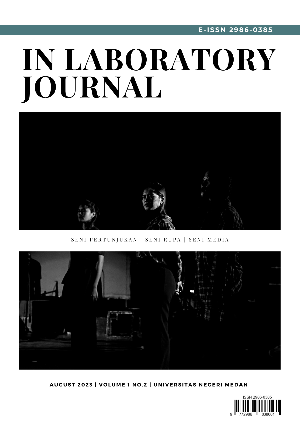Off-Screen Space Untuk Penguatan Naratif dalam Film Lakuna Sebagai Interpretasi Kekerasan Seksual
DOI:
https://doi.org/10.24114/ilj.v1i2.49993Abstract
Off-Screen Space merupakan ruang yang tidak terlihat dan cenderung diabaikan. Dalam pembuatan film, pembuat film cenderung lebih fokus pada mise-en-scene yang terlihat di layar. Sehingga peran ruang di luar layar berkurang. Padahal hubungan antara ruang di layar dan ruang di luar layar memiliki kontribusi yang sama jika pembuat film memberikan kesempatan yang sama pada kedua ruang tersebut. Dalam film Lakuna, memanfaatkan ruang off-screen dalam pengembangan naratif melalui ekspresi karakter, motif visual cermin dan suara diegetik off-screen dalam memaknai kekerasan seksual yang dialami oleh karakter-karakter dalam film Lakuna.References
Artana, I. M. A. W. D. (2022). Penggunaan Diegetic Off-Screen sebagai Pembentuk Imajinasi Visual pada Pemanfaatan Ruang di Luar Layar dalam Sinema. IMAJI: Film, Fotografi, Televisi, & Media Baru, 13(3), 190-201.
Ariansah, M. (2021). Off-Screen Space dalam Film-Film Robert Bresson: Sebuah Pendekatan Psikoanalisis terhadap A Man Escaped dan The Trial of Joan of Arc.
Ascher, S., & Pincus, E. (2007). The filmmaker's handbook: A comprehensive guide for the digital age. Penguin.
Bazin, A. (2004). What is Cinema? vol. I (Vol. 20). Berkeley, CA: University of California Press.
Block, B. (2020). The visual story: Creating the visual structure of film, TV, and digital media. Routledge.
Burch, N. (2014). Theory of film practice (Vol. 507). Princeton University Press.
Bordwell, D., Thompson, K., & Smith, J. (1993). Film art: An introduction (Vol. 7, p. 437). New York: McGraw-Hill.
Deleuze, G. (2019). Cinema I: The movement-image. In Philosophers on Film from Bergson to Badiou: A Critical Reader (pp. 152-176). Columbia University Press.
Giannetti, L. D., & Leach, J. (1999). Understanding movies (Vol. 1, No. 1, p. 999). Upper Saddle River, NJ: Prentice Hall.
Pratista, H. (2017). Memahami Film-Edisi 2. Yogyakarta: Montase press.
Rifandi, I. (2022). The Development Of Makyong Acting Training Method For Environment Of Traditional Theater Courses. Gondang: Jurnal Seni dan Budaya, 6(2).
Stanley, J., & Monta, M. (2007). Directing for Stage and Screen. Springer.
Downloads
Published
How to Cite
Issue
Section
License
Copyright (c) 2023 Muhammad Iskandar Pratama, Yusril Yusril

This work is licensed under a Creative Commons Attribution-NonCommercial-NoDerivatives 4.0 International License.
Copyright of In Laboratory Journal
Copyright for published papers is assigned to the author. The undersigned represents and warrants that the paper is original and that he or she is the author of the paper, except for material clearly identified as the original source, with a notice of permission from the copyright owner where required. The undersigned certifies that the person concerned has the power and authority to make and carry out this assignment.







